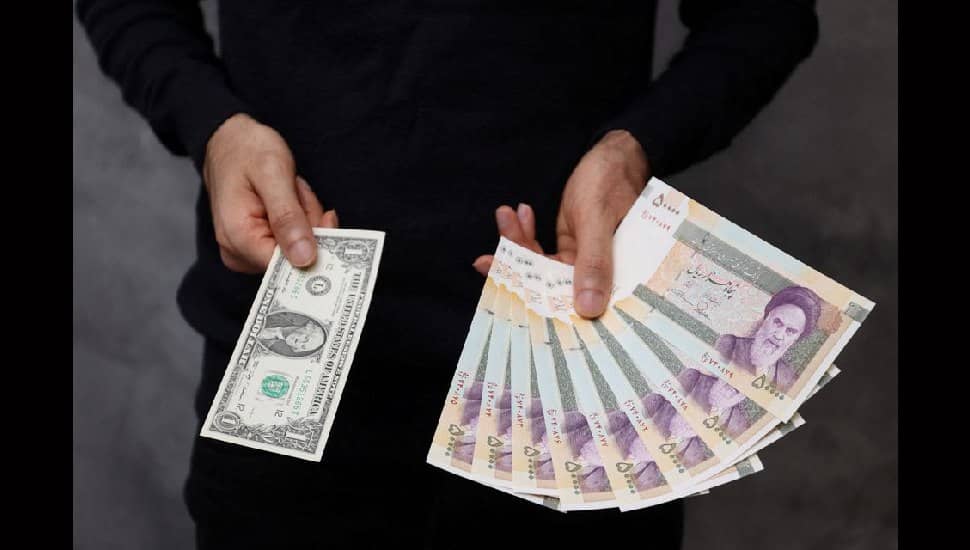
The currency price in Iran witnessed an unprecedented surge on the first day of the week and the market opening, with hourly jumps setting new records. By the evening of Saturday, February 25, the value of a dollar had skyrocketed to over 57,000 tomans, increasing by 8% in just one day. The fall of the country’s currency has led to the Parliament of the regime convening a closed session to discuss a solution to this situation. Mohammad Mokhbar, the first vice president of the regime, Ehsan Khandozi, the Minister of Economy, and Mohammad Reza Farzin, the head of the central bank, attended the meeting. Regarding the outcome of this meeting, Mohammad Baqer Ghalibaf, the speaker of the regime’s Parliament said: “We reached a good conclusion for organizing the market. We need serious and strong coordination between the Parliament and the government to organize the currency market.”
Even individuals within the regime mock the claim that a solution for this significant crisis was found in a one-hour meeting. Hemmati, the former head of the regime’s central bank, wrote in his tweet: “If you think you can solve the exchange rate crisis in just one hour, what have you been doing until now? Does the economic team comprehend the effects of a dollar valued at 56,000 Tomans on the lives and livelihoods of the people?”
Concerning the same closed meeting, Ehsan Khandozi, the Minister of Economy, said: “Many disruptors in the currency market have been arrested, some of whom have clearly mentioned their purpose and plan to disrupt the currency market.”
It is a commonly observed pattern that when the regime faces a crisis or finds itself in a deadlock, it resorts to arresting and imprisoning currency brokers and, in some cases, even executing some of them. The reasoning behind such actions is to shift the blame for the crisis onto these individuals and distract public attention from the underlying issues that have led to the crisis. The regime has employed this strategy of scapegoating throughout its history as a means of deflecting responsibility and avoiding accountability for its own failures.
However, such methods and criminal actions are widely known and do not effectively address the root causes of the crisis. Instead, they often exacerbate the anger and resentment of the people towards the regime. Delkhosh Abatari, a member of the regime’s Parliament, even acknowledged on December 25, 2022, that “everyone knows that 90% of the currency is in the hands of the government.”
On February 21, 2023, the Iranian regime made another artificial attempt to tackle the crisis by launching a new institution called the currency and gold exchange center, which was claimed to stabilize the market and sell currency to applicants based on the real exchange rate of gold and currency on a daily basis. However, the trick failed to produce any tangible results. Within just five days of the announcement, the exchange rate in the market had already increased by 28%, indicating that the measure had no impact on the economy.
The regime’s recent initiatives, such as the launch of the currency and gold exchange center, are attempts to shift the public’s focus away from the root cause of the economic crisis. In reality, the root cause is the regime’s policy of systematically plundering the assets of the people. This is accomplished primarily by manipulating the exchange rate, disproportionately impacting the most vulnerable segments of Iranian society, including low-income earners and the underprivileged. Rather than addressing the fundamental issue at hand, the regime continues to engage in tactics aimed at masking its true intentions and diverting attention from its own culpability in the economic crisis.
The regime has resorted to increasing the price of the dollar in order to finance a portion of its budget deficit. In fact, over a period of just 40 days ending on February 20, the central bank earned over 110 trillion tomans from the surge in the dollar’s price and its subsequent sale on the market. This strategy of manipulating the exchange rate has allowed the regime to generate significant revenue at the expense of the Iranian people, particularly those who belong to the lower socio-economic classes or rely on fixed salaries.
The regime’s risky strategy of exploiting the Iranian people’s assets has intensified the already volatile situation in Iranian society, creating an even more profound sense of dissatisfaction and frustration among the populace, and even the regime’s own media outlets sound the alarm about the dangers of these policies.
On February 25, the state-run newspaper Jahan Sanat published an article warning about the dangers of the regime’s policies, stating that the “game” of manipulating currency, coins, and gold, as well as taking money from people’s pockets and using the stock market and capital to fill the government’s coffers, would not end well.
Recent remarks by top regime officials show depth of economic crisis & their fear of popular anger. Four decades of mullahs' rule has all but destroyed #Iran’s economy. The only solution is the overthrow of the medieval regime & establishment of democracy. #FreeIran #IranProtests
— Mohammad Mohaddessin (@Mohaddessin) April 26, 2018
The state-run Sharq newspaper also warned on February 25, “If this year the social issues caused political turmoil, next time it is the economic issues that will make politics chaotic.” This clearly indicates that even the regime’s own media are aware of the dangers posed by these policies and are speaking out about them.
The regime finds itself in a deadlock, relying on exploiting and looting the Iranian people by increasing the currency price. However, this dangerous game will only exacerbate the already explosive situation in society, leading to more popular protests and uprisings.